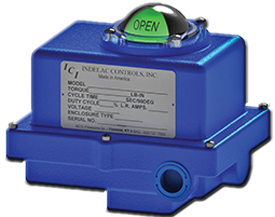Fail-safe Actuator, that simple short phrase commands many different visions of various types of actuators. If you Google Failsafe Actuator you would get 1,910,000 results. If one is going to use a fail-safe actuator in their application you might say they have their work cut out for them selecting the right actuator for their application. With so many Google results the first logical question would be; what is a fail-safe actuator?
By its most basic definition a fail-safe actuator is a machine that stores energy to position a driven device to a predetermined safe position upon loss of power. TermWiki describes a spring return actuator (fail-safe actuator) as “A valve Actuator that compressed an internal spring when the actuator moves the flow control element away from its starting position (open or closed) and then uses the energy stored in the spring to move the flow control element back toward its starting position”.
Next one might ask how many different types of fail-safe actuators are available. In that 1,910,000 Google results there are only three basic categories which include pneumatic, electric and electrohydraulic. However, within each category there is a wide range of different designs available; for example within the pneumatic family there is the rack and pinion, cylinder, scotch yoke, vane, diaphragm and more each one designed for a specific group of applications. A few examples of different electric fail-safe actuator designs are the battery backup system, rack and pinion.
Now that we have determined what a fail-safe (spring return) actuator is and how many categories there are it obviously would not be practical to try to provide an overview of all the different types available; however, it would be helpful to outline a few of the more commonly used.
The first style I would like to review is the pneumatic rack and pinion spring return actuator.
The pneumatic spring return actuator is one of the most widely used fail-safe actuators in the world. This is primarily because of the pneumatic actuator simplicity of operation and low initial investment particularly if there are air lines already available. In addition to low initial cost there are many other reasons to consider pneumatic actuators for failsafe applications. Pneumatic actuators are light weight, fast acting, not affected by duty cycle, readily available, easy to install, wide torque range to select from and there are numerous vendors to assist with selection.
While there are many reasons to consider rack and pinion for fail-safe applications there are some operational concerns to consider as well. Some factors to consider would be airline installation, maintenance, low ambient temperature; moisture in airlines can pose a problem, type of control; pneumatic actuators are not as easily adapted to some of the more sophisticated controls systems in use today and cost of electricity for the compressor. According to the Department of Energy, 24 percent of the annual cost of compressed air is due to maintenance, equipment and installation while 76 percent is due directly to the cost of electricity for the compressor.
The next type of fail-safe actuator to consider is the rotary electric spring return actuator.
The electric spring return actuator uses an electric motor to drive a series of gears to rotate a drive shaft counter clockwise or clockwise depending on the desired fail-safe position. As the drive shaft rotates a series of springs are compressed or in some styles a spiral spring is tensioned storing energy in the springs. As the output shaft rotates it provides the system with rotating force as it turns. The start and ending positions are generally controlled by limit switches. At the end of the power stroke the drive shaft is held in position by an electromechanical brake or in some spring return designs a clutch system is used, upon loss of electrical power the springs return the drive shaft to its starting position.
The electric spring return actuator has been gaining in popularity over the past decade. This is due to moderate initial unit cost, low installation, operation and maintenance costs all while achieving accurate control. Furthermore, increasing torque range and advances in product design have opened up a wider range of applications. The electric spring return actuator is an ideal substitute for pneumatic spring return actuators when pressurized air is not available or the cost of installing air lines is too expensive.
Finally I would like toprovide a brief overview of the electrohydraulicfail-safe actuator.
Generally hydraulic systems are self contained closed circuit systems. The hydraulic fluid used for control is filtered and stored in a reservoir. The liquid in the hydraulic system must be recirculated, thus requiring more maintenance, and also storage, as liquids do not compress. This is beneficial to control, because the liquid in a hydraulic actuator cannot be compressed this provides rigidity when the liquid is not flowing, and precision when it is.
Electro hydraulic fail-safe actuators are available with very high torque; they are fast acting and control with incredible precision. These fail-safe actuators are expensive and prone to oil leaks requiring some maintenance and can be affected by low ambient temperatures if precautions are not taken.
When selecting a fail-safe actuator the most important thing is to know your application requirements and the available budget. Some things to consider when selecting a failsafe actuator are; power source, if air will new lines have to be installed, is the air compressor large enough for the installation. You should also consider the type of valve being controlled, torque required (remember to allow a sufficient safety factor, I recommend at least 25%), type of control, on/off or modulating, ambient temperature and long term operating cost.








